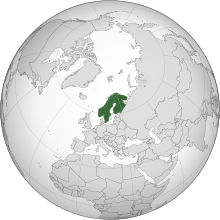geo.wikisort.org - Coast
Fennoscandia (Finnish, Swedish and Norwegian: Fennoskandia; Russian: Фенноскандия, romanized: Fennoskandiya) or the Fennoscandian Peninsula is the geographical peninsula in Europe, which includes the Scandinavian and Kola peninsulas, mainland Finland, and Karelia.[1] Administratively this roughly encompasses the mainlands of Finland, Norway and Sweden,[2] as well as Murmansk Oblast, much of the Republic of Karelia, and parts of northern Leningrad Oblast in Russia.
 Fennoscandia in March 2002 | |
 | |
| Geography | |
|---|---|
| Location | Northern Europe |
| Coordinates | 63.0000°N 17.0000°E |
| Adjacent to | Arctic Sea, Atlantic Ocean |
| Highest elevation | 2,469 m (8100 ft) |
| Highest point | Galdhøpiggen |
| Administration | |
| Mainland | |
| Mainland | |
| Mainland | |
| Whole or part of the mainland area of Murmansk Oblast, Republic of Karelia, and Leningrad Oblast | |
Its name comes from the Latin words Fennia (Finland) and Scandia (Scandinavian).[3] The term was first used by the Finnish geologist Wilhelm Ramsay in 1898.[4]
Geologically, the area is distinct because its bedrock is Archean granite and gneiss with very little limestone, in contrast to adjacent areas in Europe.
The similar term Fenno-Scandinavia is sometimes used as a synonym for Fennoscandia. Both terms are sometimes used in English to refer to a cultural or political grouping of Finland with Sweden, Norway and Denmark (the latter country is closely connected culturally and politically, but not part of the Fennoscandian Peninsula), which is a subset of the Nordic countries.[5][6]
See also
- Baltoscandia – Geopolitical concept of a Baltic–Scandinavian union
- Cap of the North – Region in Northern Europe
- Nordic countries – Geographical and cultural region in Northern Europe and the North Atlantic
- Scandinavia – Subregion of Northern Europe
- Sápmi – Cultural region traditionally inhabited by the Sami people
References
- Cummings, Vicki; Jordan, Peter; Zvelebil, Marek, eds. (2014). The Oxford Handbook of the Archaeology and Anthropology of Hunter-Gatherers. Oxford; New York: Oxford University Press. p. 838.
- Lavsund, Sten; Nygren, Tuire; Solberg, Erling (2003). "Status of moose populations and challenges to moose management in Fennoscandia". Alces. Archived from the original on 6 March 2007 – via HighBeam Research.
- "Fennoscandia [fen′ō skan′dē ə]". Your Dictionary. LoveToKnow, Corp. Retrieved 20 April 2015.
- De Geer, Sten (1928). "Das geologische Fennoskandia und das geographische Baltoskandia" [The geological Fennoscandia and the geographical Baltoscandia] (PDF). Geografiska Annaler (in German). Swedish Society for Anthropology and Geography. 10: 119–139. OCLC 604361828. Retrieved 22 April 2018.
- "Bulletin – Canadian Library Association". 20. Canadian Library Association. 1963: 179.
{{cite journal}}: Cite journal requires|journal=(help) - "Fennoscandia, n.". Oxford English Dictionary Online (2nd ed.). Oxford: Oxford University Press. December 2019. Retrieved 10 February 2020.
Further reading
- Ramsay, W., 1898. Über die Geologische Entwicklung der Halbinsel Kola in der Quartärzeit. Fennia 16 (1), 151 p.
External links
На других языках
[de] Fennoskandinavien
Fennoskandinavien, auch Fennoskandien oder Fennoskandia genannt, ist eine Bezeichnung für die nordeuropäische Halbinsel, die sich aus Finnland (Fenno-) und der Skandinavischen Halbinsel (-scandia) sowie Karelien und der Halbinsel Kola zusammensetzt. In regionalgeologischem Kontext wird dieses Gebiet, mit Ausnahme des nordwestlichen (kaledonischen) Teils des Skandinavischen Gebirges, als Fennoskandischer Schild oder auch Baltischer Schild bezeichnet.[1][2]- [en] Fennoscandia
[es] Fenoscandia
Fenoscandia o Fenoescandinavia[1] son términos geográficos y geológicos utilizados para describir la península compuesta por el conjunto de la península escandinava, la península de Kola, Carelia y Finlandia en el norte de Europa. Geológicamente, el término también alude al escudo Báltico que comprende Noruega, Suecia, Finlandia y parte de Rusia (óblast de Murmansk, parte de la República de Carelia y norte del óblast de Leningrado), que es la porción expuesta de la antigua placa Báltica. El término fue usado por primera vez por el geólogo finés Wilhelm Ramsay en 1898.[2] El Escudo Báltico tiene más de 3100 millones de años de antigüedad.Другой контент может иметь иную лицензию. Перед использованием материалов сайта WikiSort.org внимательно изучите правила лицензирования конкретных элементов наполнения сайта.
WikiSort.org - проект по пересортировке и дополнению контента Википедии